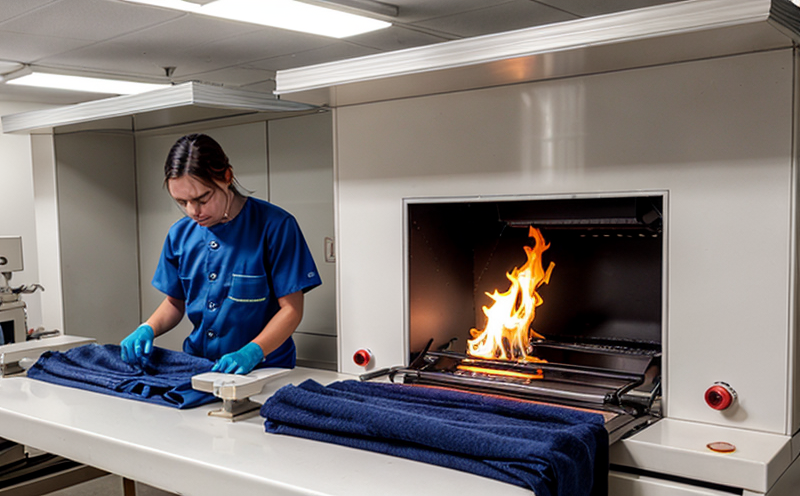Ignitability Testing of Synthetic Fabrics
The ignitability testing of synthetic fabrics is a critical aspect in ensuring the safety and compliance of textiles used across various sectors, including clothing, upholstery, automotive interiors, and home furnishings. Synthetic fabrics are widely used due to their durability, cost-effectiveness, and aesthetic appeal. However, these materials can pose significant fire risks if not properly evaluated for flammability.
Standardized testing procedures such as ISO 13565-2 and ASTM D6413 are employed to assess the ignitability of synthetic fabrics under controlled laboratory conditions. These tests provide insights into how a fabric behaves when exposed to fire, including its rate of flame spread, smoke production, and heat release. The results from these tests help manufacturers understand potential hazards and implement necessary safety measures.
The testing process involves preparing the specimen according to specific dimensions outlined in relevant standards. Specimens are then subjected to different ignition sources like a gas burner or an electric igniter. Observations during the test include measuring the time it takes for the flame to extinguish, recording the distance traveled by the flame along the fabric, and quantifying any smoke produced.
The data collected from these tests is crucial for meeting regulatory requirements set forth by organizations like the European Union's Technical Standards and the National Fire Protection Association (NFPA) in North America. Compliance with these standards ensures that products are safe for end-users and comply with international regulations aimed at reducing fire-related incidents.
Understanding the behavior of synthetic fabrics under ignitability tests also aids in product development by allowing manufacturers to make informed decisions about material selection, chemical treatments, and design modifications. For instance, flame retardants or other additives can be tested for their efficacy in enhancing the safety performance of textiles.
In summary, ignitability testing of synthetic fabrics is an essential step in safeguarding public health and ensuring product compliance with fire safety regulations. By leveraging these tests, manufacturers can develop safer products that contribute to a more secure environment for consumers.
Why It Matters
The importance of ignitability testing in synthetic fabrics cannot be overstated. Synthetic materials are prevalent in many industries due to their versatility and cost-effectiveness, but they also carry inherent risks when exposed to fire. Ignitability tests help identify these risks early in the product development process.
Regulatory compliance is a key reason for conducting ignitability testing. Standards such as ISO 13565-2 and ASTM D6413 are designed to ensure that textiles meet specified safety criteria, thereby protecting end-users from potential hazards. Non-compliance can lead to product recalls, legal issues, and damage to brand reputation.
From a consumer perspective, ignitability testing ensures the safety of everyday products such as clothing, furniture, and automotive interiors. In environments where fire risks are particularly high, like hospitals or public spaces, these tests play an even more crucial role in preventing fires that could lead to severe injuries or fatalities.
For manufacturers, ignitability testing offers valuable insights into material performance and the effectiveness of any flame retardants used. This information can guide further product improvements and innovations, making synthetic fabrics safer while maintaining their desirable properties.
In conclusion, ignitability testing is vital for ensuring that synthetic fabrics meet safety standards, comply with regulations, and provide a safe end-product for consumers.
Eurolab Advantages
Eurolab offers comprehensive ignitability testing services tailored to the specific needs of synthetic fabric manufacturers. Our expertise in this field is backed by state-of-the-art facilities and experienced professionals who stay current with international standards.
We provide a range of tests that cover various aspects of synthetic fabrics' behavior under fire conditions, including but not limited to ISO 13565-2 and ASTM D6413. Our testing capabilities are complemented by advanced equipment such as gas burners and calorimeters, which ensure precise and reliable results.
Our compliance team ensures that all tests adhere strictly to the latest international standards, guaranteeing accurate interpretations of test outcomes. This not only helps our clients meet regulatory requirements but also enhances their products' safety profile.
We pride ourselves on offering a high level of customer service, including detailed reports and recommendations for any necessary adjustments in material or design based on testing results. Additionally, Eurolab's global network allows us to provide services that are accessible to clients worldwide.
In summary, Eurolab's commitment to excellence in ignitability testing sets it apart as a leader in this field, providing unparalleled support and expertise to synthetic fabric manufacturers.
Why Choose This Test
The choice of ignitability testing for synthetic fabrics is driven by its critical role in ensuring product safety and compliance with international standards. Synthetic materials are widely used across various industries, but they can present significant fire risks if not adequately evaluated.
Regulatory compliance is a primary driver for choosing this test. Many countries have stringent regulations that mandate ignitability testing to ensure textiles meet specified safety criteria. For example, the European Union's Technical Standards and NFPA standards in North America set strict guidelines that must be adhered to by manufacturers.
Consumer protection is another compelling reason to invest in this testing. By ensuring that synthetic fabrics are safe from ignitability risks, we enhance public safety and trust in products like clothing, furniture, and automotive interiors. This is especially important in high-risk environments such as hospitals or public spaces.
For manufacturers, ignitability testing provides valuable insights into material performance and the effectiveness of flame retardants used. This information can guide further product improvements and innovations, making synthetic fabrics safer while maintaining their desirable properties.
The test also supports sustainable practices by helping companies identify more fire-resistant materials and processes, thereby reducing waste associated with flammable textiles. Ultimately, choosing ignitability testing is a strategic decision that benefits both the manufacturer and the end-user.





